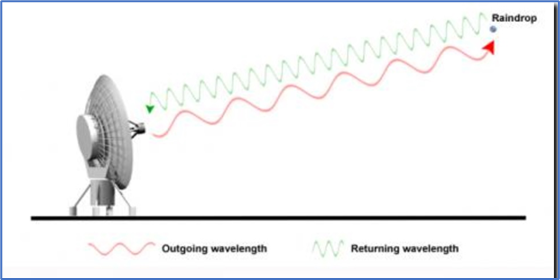Why in news?
- Union Minister of State for Earth Sciences has said that the entire country will be covered by Doppler Weather Radar Network by 2025 to predict extreme weather events more accurately.
- He made this announcement while delivering the keynote address on the occasion of 148th Foundation Day of India Meteorological Department (IMD).
What’s in today’s article?
- Weather Radars – About, working, types
- India Meteorological Department (IMD) – About, mandate
- News Summary
Weather Radars
- Weather radar is also known as Doppler weather radar.
- It is different from normal radar as it uses the Doppler Effect principle to provide information about weather forecast.
- Doppler Effect refers to the change in wave frequency during the relative motion between a wave source and its observer.
- Doppler radar systems provide accurate information regarding the movement of targets as well as their position.
- It is an instrument that sends pulses of electromagnetic energy into the atmosphere to find precipitation, determine its motion and intensity, and identify the precipitation type such as rain, snow or hail.
- When the electromagnetic pulse strikes an object such as a raindrop or a snowflake, the wave reflects back to the radar with data that can be analysed by meteorologists.
Working

- Weather radar utilizes either a solid-state or tube transmitter to send energy pulses (also known as radar beams) into the air to detect precipitation.
- This focused beam radiates outward from an antenna (also known as a radar dish).
- If the radar beam bounces off precipitation such as rain or hail, the beam will return to the weather disk, where the data is processed into various parameters.
- This enables a meteorologist to analyse and interpret the type of weather occurring dozens of miles away from the radar.
Types
- S-Band radars
- Wavelength: 8 – 15 cm
- Frequency: 2 – 4 GHz
- Use cases:
- This radar’s longer wavelength allows the beam to penetrate through several bands of precipitation, expanding the range for analysis.
- These radars help the meteorologist generate weather alerts further in advance.
- C-Band radars
- Wavelength: 4 – 8 cm
- Frequency: 4 – 8 GHz
- Use cases:
- C-Band radars are often intended for short-range weather observation but can be used in medium- to long-range precipitation analysis.
- However, the beam does attenuate (loses its strength) much more than the longer wavelength S-Band and therefore does not recognize precipitation rates as accurately as the S-Band.
- These radars are generally smaller and less expensive than S-Band weather radars, but more expensive than the smaller X-Band radar.
- X-Band radars
- Wavelength: 2.5 – 4 cm
- Frequency: 8 – 12 GHz
- Use cases
- Because of the smaller wavelength, the X band radar is more sensitive and can detect smaller particles.
- Hence, these radars are used for studies on cloud development.
- Most major airplanes are equipped with an X band radar to pick up turbulence and other weather phenomena.
India Meteorological Department (IMD)
- Formed in 1875, the IMD is a principal agency responsible for meteorological observations, weather forecasting and seismology.
- It works under the Ministry of Earth Sciences, Govt of India.
- Headquartered at Delhi, IMD operates hundreds of observation stations across India and Antarctica.
- IMD became a member of the World Meteorological Organisation in April 1949.
Mandate of IMD
- To take meteorological observations and to provide current and forecast meteorological information for optimum operation of weather-sensitive activities like agriculture, irrigation/water resource management, industries, shipping, aviation, offshore oil explorations, etc.
- To warn against severe weather phenomena like tropical cyclones, heavy rains and snow, cold and heat waves, etc.
News Summary
- IMD has announced to cover the entire country under sophisticated radar network by deploying 25 additional Doppler Weather Radars (DWRs).
- To establish 720 District Agro Meteorological Units (DAMUs) to provide more precise farm-related advisories and forecasts to farmers by 2025.
- The IMD also decided to increase its agro-meteorological service facilities from 3,100 blocks in 2023 to 7,000 blocks in 2025.
- It also announced to bring Delhi, Kolkata and Guwahati under its urban flood warning system in coming years.
- The urban flood warning system, introduced in Mumbai in July 2020, is currently operational in two cities including Chennai.
Significance of this move
- It can prove to be an important tool to avert disasters in many states, specifically the ones struck by thunderstorms lightning, floods and heavy rains.
- In 2022, thunderstorms and lightning claimed the highest 1,285 lives (58% of total casualties of 2,227) followed by floods and heavy rains (835) in India.
- Besides protecting lives, warning and advisory services will help farmers and fishermen to improve their income.










